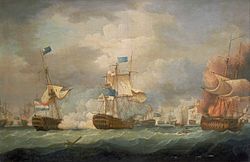Anglo-Dutch Wars
The Anglo-Dutch Wars (Dutch: [Engels–Nederlandse Oorlogen] Error: {{Lang}}: text has italic markup (help) or Dutch: [Engelse Zeeoorlogen] Error: {{Lang}}: text has italic markup (help)) were a series of wars fought between the Dutch Republic and the Kingdom of England and later the United Kingdom of Great Britain during the 17th and 18th centuries. They fought for control over trade routes on the seas. All of the wars were mostly fought by naval warfare.
| Anglo-Dutch Wars | |||||||
|---|---|---|---|---|---|---|---|
 Dutch attack on the Medway during the Second Anglo-Dutch War by Pieter Cornelisz van Soest, c. 1667. | |||||||
| |||||||
| Belligerents | |||||||
|
|
| ||||||
| Commanders and leaders | |||||||
|
|
| ||||||
| Strength | |||||||
|
Dutch Republic 600 warships 1,500 Marines 50 soldiers Denmark–Norway Fortress, 250 soldiers |
England 650 warships 300 soldiers France 60 ships | ||||||
| Casualties and losses | |||||||
|
Dutch Republic 56 warships lost 20 warships captured 10,150 dead 20,000 wounded 2,500 captured Denmark–Norway 8 dead 10 civilians killed |
England 40 warships lost 18 warships captured 13,310 dead 25,000 wounded 2,000 captured France 400 killed | ||||||
The First War (1652–1654) took place during the Interregnum in England, the period after the English Civil War when England did not have a king or a queen. The war was fought between the navies of England and the Dutch Republic (also known as the United Provinces). It mainly took place in the English Channel and the North Sea. It ended with the Royal Navy of England gaining control of those seas and a monopoly over trade with the English colonies.[1]
The Second (1665–1667) and the Third (1672–1674) Wars happened after the English Restoration of the monarchy. England tried to end the Dutch monopoly over world trade. Most of the fighting in both wars was done in the North Sea. In the Third War, England fought alongside France. Both wars ended in strong victories for the Dutch and confirmed their position as the leading maritime power of the 17th century. The English took New Netherland, and the Dutch let them keep it in return for Suriname.
The Fourth War (1780–1784) took place after the Acts of Union 1707 in Great Britain and involved the Dutch Republic and Great Britain. The main cause was that Britain disagreed with the Dutch trading with the United States during the American Revolutionary War. The war ended with the Treaty of Paris (1784) and ended with a very big defeat for the Dutch,[2] who lost parts of the Dutch Empire.
Anglo-Dutch Wars Media
Dutch factory at Ambon Island, early to mid-17th century
Before the Battle of the Downs by Reinier Nooms, circa 1639, depicting the Dutch blockade off the English coast, the vessel shown is the Aemilia, Tromp's flagship.
The Battle of Scheveningen, 10 August 1653
The Battle of Lowestoft, 13 June 1665.
The 1667 raid on the Medway.
The Battle of Texel, 21 August 1673.
The 1797 battle of Camperdown (Thomas Whitcombe, 1798)
Related pages
References
- ↑ Rickard, J. (11 December 2000), First Anglo-Dutch War (1652-1654), History of War.
- ↑ Edler, F. (2001) [1911], The Dutch Republic and The American Revolution, Honolulu, Hawaii: University Press of the Pacific, p. 88, ISBN 0-89875-269-8
More reading
- D. R. Hainsworth, et al. (1998) The Anglo-Dutch Naval Wars 1652-1674
- James Rees Jones (1996) The Anglo-Dutch wars of the seventeenth century
- Angus Konstam and Tony Bryan (2011) Warships of the Anglo-Dutch Wars 1652-74
Other websites
- Painting of Anglo-Dutch sea battle, Third War, at the National Maritime Museum, London (in Nederlands), NL: Zeeburg nieuws, archived from the original on 2002-10-14, retrieved 2013-07-16.
- National Maritime Museum Archived 2011-12-12 at the Wayback Machine, London.
- Dutch Admiral Michiel de Ruyters' flagship 'The Seven Provinces' Archived 2007-09-27 at the Wayback Machine is being rebuilt in the Dutch town of Lelystad.
- A short history of the Anglo–Dutch Wars, Contemplator.






